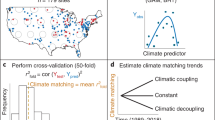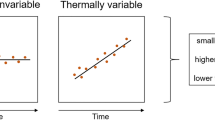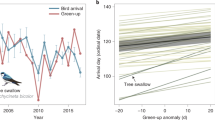Abstract
The ecological impacts of modern global climate change are detectable in a wide variety of phenomena, ranging from shifts in species ranges to changes in community composition and human disease dynamics1,2,3. So far, however, little attention has been given to temporal changes in spatial synchrony—the coincident change in abundance or value across the landscape4—despite the importance of environmental synchrony as a driver of population trends and the central role of environmental variability in population rescue and extinction1,5,6. Here we demonstrate that across North America, spatial synchrony of a significant proportion of 49 widespread North American wintering bird species has increased over the past 50 years—the period encompassing particularly intense anthropogenic effects in climate—paralleling significant increases in spatial synchrony of mean maximum air temperature. These results suggest the potential for increased spatial synchrony in environmental factors to be affecting a wide range of ecological phenomena. These effects are likely to vary, but for North American wildlife species, increased spatial synchrony driven by environmental factors may be the basis for a previously unrecognized threat to their long-term persistence in the form of more synchronized population dynamics reducing the potential for demographic rescue among interacting subpopulations.
This is a preview of subscription content, access via your institution
Access options
Subscribe to this journal
Receive 12 print issues and online access
$209.00 per year
only $17.42 per issue
Buy this article
- Purchase on Springer Link
- Instant access to full article PDF
Prices may be subject to local taxes which are calculated during checkout




Similar content being viewed by others
References
McLaughlin, J. F., Hellmann, J. J., Boggs, C. L. & Ehrlich, P. R. Climate change hastens populations extinctions. Proc. Natl Acad. Sci. USA 99, 6070–6074 (2002).
Patz, J. A., Campbell-Lendrum, D., Holloway, T. & Foley, J. A. Impact of regional climate change on human health. Nature 438, 310–317 (2005).
Walther, G.-R. et al. Ecological reponses to recent climate change. Nature 416, 389–395 (2002).
Liebhold, A., Koenig, W. D. & Bjørnstad, O. N. Spatial synchrony in population dynamics. Annu. Rev. Ecol. Evol. Syst. 35, 467–490 (2004).
Brown, J. H. & Kodric-Brown, A. Turnover rates in insular biogeography: effect of immigration on extinction. Ecology 58, 445–449 (1977).
Harrison, S. & Quinn, J. F. Correlated environments and the persistence of metapopulations. Oikos 56, 293–298 (1989).
Ripa, J. Analysing the Moran effect and dispersal: their significance and interaction in synchronous population dynamics. Oikos 89, 175–187 (2000).
Ims, R. A. & Andreassen, H. P. Spatial synchronization of vole population dynamics by predatory birds. Nature 408, 194–196 (2000).
Small, R. J., Marcström, V. & Willebrand, T. Synchyronous and nonsynchronous population fluctuations of some predators and their prey in central Sweden. Ecography 16, 360–364 (1993).
Moran, P. A. P. The statistical analysis of the Canadian lynx cycle. II. Synchronization and meteorology. Aust. J. Zool. 1, 291–298 (1953).
Ranta, E., Kaitala, V., Lindström, J. & Helle, E. The Moran effect and synchrony in population dynamics. Oikos 78, 136–142 (1997).
Earn, D. J. D., Levin, S. A. & Rohani, P. Coherence and conservation. Science 290, 1360–1364 (2000).
Heino, M., Kaitala, V., Ranta, E. & Lindström, J. Synchronous dynamics and rates of extinction in spatially structured populations. Proc. R. Soc. Lond. B 264, 481–486 (1997).
Stenseth, N. C. et al. Studying climate effects on ecology through the use of climate indices: the North Atlantic Oscillation, El Niño Southern Oscillation and beyond. Proc. R. Soc. Lond. B 270, 2087–2096 (2003).
Post, E. & Forchhammer, M. C. Spatial synchrony of local populations has increased in association with the recent Northern Hemisphere climate trend. Proc. Natl Acad. Sci. USA 101, 9286–9290 (2004).
Koenig, W. D. Spatial autocorrelation and local disappearances in wintering North American birds. Ecology 82, 2636–2644 (2001).
Koenig, W. D. Global patterns of environmental synchrony and the Moran effect. Ecography 25, 283–288 (2002).
Strong, C., Zuckerberg, B., Betancourt, J. L. & Koenig, W. D. Climatic dipoles drive two principal modes of North American boreal bird irruption. Proc. Natl Acad. Sci. USA 112, E2795–E2802 (2015).
Hansen, J. et al. Global temperature change. Proc. Natl Acad. Sci. USA 103, 14288–14293 (2006).
Cai, W. et al. Increasing frequency of extreme El Niño events due to greenhouse warming. Nature Clim. Change 4, 111–116 (2014).
Goodkin, N. F., Hughen, K. A., Doney, S. C. & Curry, W. B. Increased multidecadal variability of the North Atlantic Oscillation since 1781. Nature Geosci. 1, 844–848 (2008).
Hurrell, J. W. Decadal trends in the North Atlantic Oscillation: regional temperatures and precipitation. Science 269, 676–679 (1995).
Post, E. Ecology of Climate Change: The Importance of Biotic Interactions (Princeton Univ. Press, 2013).
Post, E. & Forchhammer, M. C. Synchronization of animal population dynamics by large-scale climate. Nature 420, 168–171 (2002).
Hansen, B. B. et al. Climate events synchronize the dynamics of a resident vertebrate community in the high Arctic. Science 339, 313–315 (2013).
Hanski, I. Metapopulation Ecology (Oxford Univ. Press, 1999).
Palmqvist, E. & Lundberg, P. Population extinctions in correlated environments. Oikos 83, 359–367 (1998).
Hanski, I. Dispersal (eds Clobert, J., Danchin, E., Dhondt, A. A. & Nichols, J. D.) 283–298 (Oxford Univ. Press, 2001).
Stacey, P. B. & Taper, M. Environmental variation and the persistence of small populations. Ecol. Appl. 2, 18–29 (1992).
Bjørnstad, O. N. & Falck, W. Nonparametric spatial covariance functions: estimation and testing. Environ. Ecol. Stat. 8, 53–70 (2001).
Bjørnstad, O. N. ncf: Spatial Nonparametric Covariance Functions R package v. 1.1-5 (2013); https://CRAN.R-project.org/web/packages/ncf/index.html
Bock, C. E. & Root, T. L. The Christmas Bird Count and avian ecology. Stud. Avian Biol. 6, 17–23 (1981).
Global Historical Climate Network versions 3.2.0 (monthly; http://www.ncdc.noaa.gov/ghcnm/v3.php) and 3.12 (daily; http://www.ncdc.noaa.gov/oa/climate/ghcn-daily) (2013).
Taylor, W. E. On the efficiency of the Cochrane–Orcutt estimator. J. Econom. 17, 67–82 (1981).
Acknowledgements
We thank A. Allstadt, J. Buonaccorsi, C. Cooper, A. Dhondt, W. Hochachka and B. Zuckerberg for comments, discussion and statistical advice. This work was funded by National Science Foundation grants IOS-0918944 and DEB-1256394 to W.D.K.
Author information
Authors and Affiliations
Contributions
W.D.K. conducted the data analysis; A.M.L. provided critical advice regarding the approach and analyses. Both authors contributed to writing the paper.
Corresponding author
Ethics declarations
Competing interests
The authors declare no competing financial interests.
Supplementary information
Supplementary Information
Supplementary Information (PDF 1064 kb)
Rights and permissions
About this article
Cite this article
Koenig, W., Liebhold, A. Temporally increasing spatial synchrony of North American temperature and bird populations. Nature Clim Change 6, 614–617 (2016). https://doi.org/10.1038/nclimate2933
Received:
Accepted:
Published:
Issue Date:
DOI: https://doi.org/10.1038/nclimate2933
This article is cited by
-
Reduced resilience of terrestrial ecosystems locally is not reflected on a global scale
Communications Earth & Environment (2021)
-
RETRACTED ARTICLE: Tree growth in sync
Nature Ecology & Evolution (2020)
-
RETRACTED ARTICLE: Evidence of unprecedented rise in growth synchrony from global tree ring records
Nature Ecology & Evolution (2020)
-
High abundance and reproductive output of an intertidal limpet (Siphonaria japonica) in environments with high thermal predictability
Marine Life Science & Technology (2020)
-
Climate-Altered Wetlands Challenge Waterbird Use and Migratory Connectivity in Arid Landscapes
Scientific Reports (2019)



